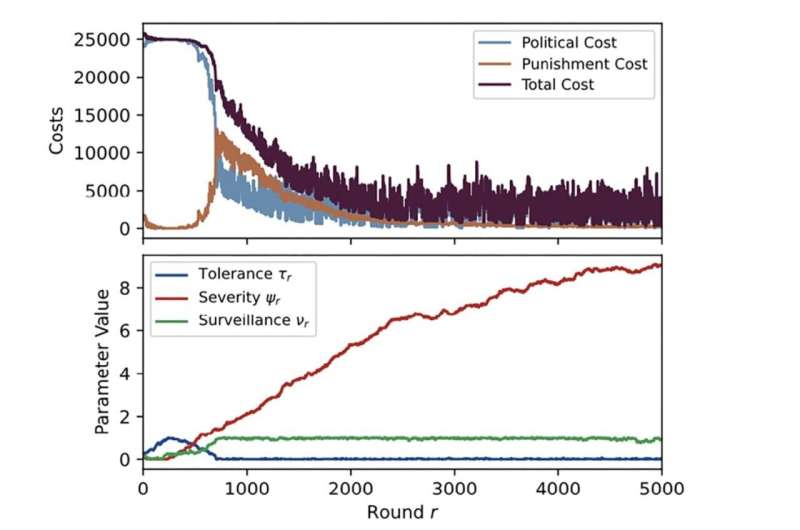Science
New Study Reveals Dynamics of Self-Censorship in Society

A recent study from Arizona State University (ASU) and the University of Michigan has uncovered the complex dynamics of self-censorship, particularly in contexts where expressing dissent carries significant risks. Published on November 3, 2025, in the Proceedings of the National Academy of Sciences, the research provides a detailed analysis of the strategic choices individuals make when faced with potential punishment for their opinions.
The study, co-authored by Professor Stephanie Forrest and Assistant Professor Joshua J. Daymude from ASU, alongside renowned political scientist Robert Axelrod, introduces a mathematical framework to better understand when people decide to voice their dissent or refrain from doing so. This work sheds light on the intricate interactions between surveillance, punishment, and individual boldness, especially under authoritarian regimes where speaking out can lead to severe consequences.
Understanding the Mechanisms of Dissent
The paper, titled “Strategic Analysis of Dissent and Self-Censorship,” explores how both individuals and governing bodies can influence each other’s behaviors over time. According to Daymude, “Modern technologies—from facial recognition to algorithmic content moderation—have transformed the landscape of dissent.” The researchers aimed to provide a structured method to understand the emergence of self-censorship beyond mere intuition.
Employing simulations, the researchers examined how individuals weigh their desire to express dissent against the fear of retribution. The findings indicate that self-censorship is not merely a reaction to fear; it serves as a rational, calculated response shaped by the interplay of boldness, surveillance, and the severity of punishments.
The study identifies three primary behaviors: compliance, self-censorship, and defiance. The data revealed that uniform punishments, such as internet shutdowns, typically lead to widespread self-censorship. Conversely, when penalties escalate with repeated infractions, individuals may still take calculated risks to express their opinions. Forrest notes, “A population’s willingness to speak out early on, and suffer the negative consequences, has an outsized effect on how long it takes an authority to suppress all dissent.”
The Broader Implications of Self-Censorship
The research highlights significant historical parallels, such as Chairman Mao Zedong’s “Hundred Flowers Campaign,” which initially encouraged open criticism before tightening control. The mathematical model demonstrated that as tolerance diminishes and surveillance increases, self-censorship becomes more pervasive, leading to near-total compliance over time. However, populations exhibiting greater “boldness”—a measure of their willingness to risk punishment—tend to resist authority more effectively.
The implications of this research extend beyond academic theory. In today’s global landscape, citizens in authoritarian regimes and users navigating content moderation on social platforms face similar pressures regarding public expression. Daymude emphasizes, “Self-censorship can start as a form of self-protection. But when people begin to silence themselves preemptively, before any punishment occurs, it becomes a powerful tool for control.”
The collaborative effort between Forrest and Daymude reflects an interdisciplinary approach, merging computer science with social science to address one of humanity’s oldest political questions: what influences individuals to speak or remain silent? Their work aims to provide insights that could inform policymakers, platform designers, and advocates for free expression.
Ultimately, the findings stress that the preservation of open dialogue relies not only on legal frameworks and technology but also on the courage of individuals to maintain their voices, even in uncomfortable situations. As Forrest concludes, “The courage of individuals and the collective willingness to keep speaking is essential for fostering a culture of open dialogue.”
-

 Science3 weeks ago
Science3 weeks agoIROS 2025 to Showcase Cutting-Edge Robotics Innovations in China
-

 Politics3 weeks ago
Politics3 weeks agoJudge Considers Dismissal of Chelsea Housing Case Citing AI Flaws
-

 World3 weeks ago
World3 weeks agoBravo Company Veterans Honored with Bronze Medals After 56 Years
-

 Lifestyle3 weeks ago
Lifestyle3 weeks agoStone Island’s Logo Worn by Extremists Sparks Brand Dilemma
-

 Health3 weeks ago
Health3 weeks agoStartup Liberate Bio Secures $31 Million for Next-Gen Therapies
-

 Top Stories3 weeks ago
Top Stories3 weeks agoIndonesia Suspends 27,000 Bank Accounts in Online Gambling Crackdown
-

 Health3 weeks ago
Health3 weeks agoTop Hyaluronic Acid Serums for Radiant Skin in 2025
-

 World3 weeks ago
World3 weeks agoHoneywell Predicts Record Demand for Business Jets Over Next Decade
-

 Sports3 weeks ago
Sports3 weeks agoMel Kiper Jr. Reveals Top 25 Prospects for 2026 NFL Draft
-

 Lifestyle3 weeks ago
Lifestyle3 weeks agoMary Morgan Jackson Crowned Little Miss National Peanut Festival 2025
-

 Sports3 weeks ago
Sports3 weeks agoYamamoto’s Mastery Leads Dodgers to 5-1 Victory in NLCS Game 2
-

 Science3 weeks ago
Science3 weeks agoArizona State University Transforms Programming Education Approach









